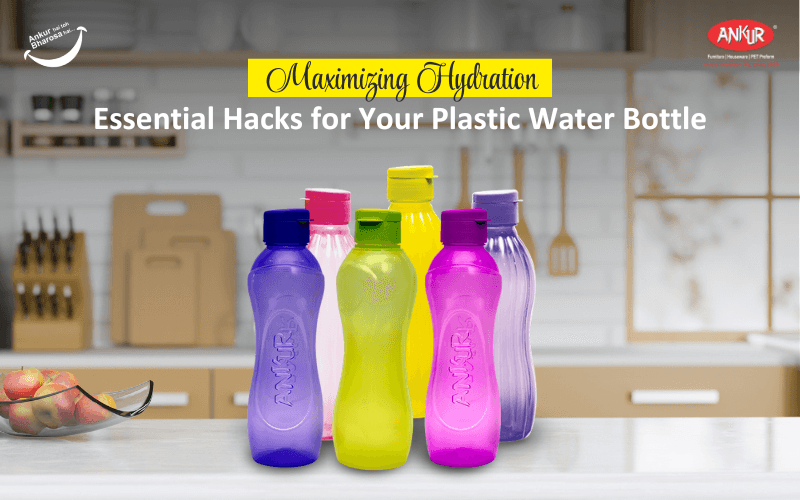Maximizing Hydration: Essential Hacks for Your Plastic Water Bottle

Introduction: The Importance of Hydration
Staying hydrated is essential for maintaining overall health and well-being. Our bodies rely on water to function properly, aiding in digestion, circulation, temperature regulation, and more. One of the simplest and most convenient ways to ensure adequate hydration throughout the day is by carrying a water bottle with you wherever you go.
Choosing the Right Water Bottle
When it comes to selecting a water bottle, there are various options available, including stainless steel, glass, and plastic. Plastic water bottles remain a popular choice due to their affordability, durability, and lightweight nature. However, not all plastic bottles are created equal, so it’s crucial to consider factors such as material quality and safety certifications.
Factors to Consider
Before purchasing a plastic water bottle, take into account factors like size, shape, and cap design. Opt for bottles with wide openings for easy filling and cleaning, and consider ones that are dishwasher safe for convenience.
Benefits of Plastic Water Bottles
Plastic water bottles are highly versatile and suitable for various activities, whether you’re hitting the gym, going for a hike, or simply running errands. Their lightweight construction makes them ideal for on-the-go hydration, and many are designed to fit in standard cup holders, backpack pockets, or bike cages.
Hydration Hacks for Plastic Water Bottles
Maximizing the efficiency and enjoyment of your plastic water bottle involves implementing some simple yet effective hydration hacks.
Tracking Your Intake
To ensure you’re drinking enough water throughout the day, consider using a water tracking app or marking your bottle with time-based goals. This visual reminder can help you stay on track and monitor your progress towards meeting daily hydration targets.
Infusing Flavors
Enhance the taste of your water by infusing it with natural flavors like citrus fruits, berries, or herbs. Simply add your desired ingredients to the bottle, let them steep for a few hours, and enjoy a refreshing and flavorful beverage without any added sugars or artificial sweeteners.
Adding Electrolytes
For added hydration and electrolyte replenishment, consider adding electrolyte tablets or powder to your water bottle. This can be especially beneficial during intense workouts or hot weather conditions when electrolyte loss is more pronounced.
Freezing for Longer Lasting Cold Water
Fill your plastic water bottle halfway with water and freeze it overnight. In the morning, top it off with fresh water before heading out. This not only keeps your water cold for longer but also provides a gradual release of chilled water as the ice melts throughout the day.
Utilizing Insulated Bottles
Invest in an insulated plastic water bottle to keep your beverages cold for extended periods, even in hot environments. These bottles are designed with double-wall insulation to prevent condensation and maintain the temperature of your drink, whether it’s icy cold or piping hot.
Safety Measures with Plastic Water Bottles
While plastic water bottles offer convenience and portability, it’s essential to be aware of potential safety concerns associated with their use.
Avoiding Harmful Chemicals
Choose BPA-free and phthalate-free plastic water bottles to minimize exposure to harmful chemicals that may leach into your water. Look for bottles labeled as “food-grade” or “FDA approved” to ensure they meet safety standards for storing beverages.
Proper Cleaning and Maintenance
Regularly clean and sanitize your plastic water bottle to prevent bacterial growth and odors. Use a bottle brush or cleaning tablets to reach all areas, and allow the bottle to air dry thoroughly between uses. Avoid exposing plastic bottles to high temperatures or harsh chemicals, as this can degrade the material and compromise its integrity.
Environmental Impact of Plastic Water Bottles
While plastic water bottles offer convenience, their widespread use contributes to environmental pollution and resource depletion.
Recycling and Reuse
Reduce your environmental footprint by recycling plastic water bottles whenever possible. Many communities offer curbside recycling programs, or you can drop off empty bottles at recycling centers. Additionally, consider investing in reusable plastic water bottles to minimize single-use plastic consumption and promote sustainability.
Alternatives to Single-Use Plastic
Explore alternative options for staying hydrated on the go, such as stainless steel or glass water bottles. These durable and eco-friendly alternatives are reusable, reducing the need for disposable plastic bottles and minimizing environmental harm.
Conclusion
With the right hydration hacks and safety precautions, you can make the most out of your plastic water bottle while staying hydrated and environmentally conscious. By choosing high-quality bottles, implementing practical tips, and prioritizing sustainability, you can enjoy refreshing hydration wherever life takes you.
